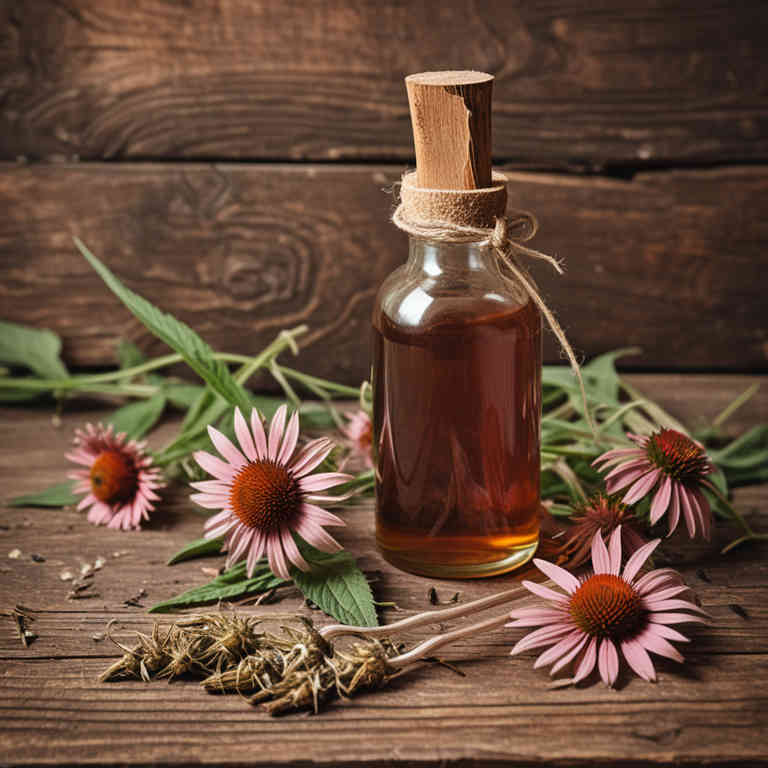Echinacea pallida tincture for medicinal use

Echinacea pallida tincture is a concentrated herbal preparation made from the dried roots and flowers of the Echinacea pallida plant, commonly known as the pale coneflower.
It is widely used in herbalism to support immune function and is often taken during the onset of cold or flu symptoms to help reduce their severity. The tincture is typically prepared using alcohol as a solvent to extract the active compounds from the plant material. In traditional herbal practice, it is valued for its purported anti-inflammatory and antimicrobial properties.
It is usually taken in small doses, often diluted in water or another liquid, to promote its therapeutic effects.
Uses
Echinacea pallida tincture has been used to support immune function and treat respiratory infections for centuries, particularly among Native American tribes who traditionally used the plant for its healing properties.
Historically, it was employed to alleviate symptoms of colds, flu, and other upper respiratory conditions. In modern times, it is commonly used as a natural remedy to reduce the severity and duration of colds and flu, often in the form of tinctures or extracts. Scientific studies have suggested that echinacea may have antimicrobial and anti-inflammatory properties that contribute to its effectiveness.
However, its use remains controversial, with varying results in clinical trials, and it is often recommended as a complementary rather than a primary treatment.
Benefits
Echinacea pallida tincture has health benefits such as boosting the immune system and reducing the duration of colds and respiratory infections.
It is commonly used to support the body's natural defenses against viral infections. The tincture contains compounds like alkamides, caffeic acid derivatives, and polysaccharides, which may contribute to its immunostimulant properties. It is often taken as a supplement during the cold and flu season to help prevent or alleviate symptoms.
However, it is important to consult a healthcare professional before use, especially for individuals with allergies or chronic health conditions.
Constituents
Echinacea pallida tincture active constituents include alkamides, caffeic acid derivatives, polysaccharides, and flavonoids.
These compounds are believed to contribute to the herb's immune-modulating properties. Alkamides may help stimulate white blood cell activity, while polysaccharides can enhance immune response. Caffeic acid derivatives possess antioxidant and anti-inflammatory effects.
Flavonoids also support overall immune function and may reduce the severity of colds and respiratory infections.
Preparation
To make Echinacea pallida tincture, begin by harvesting the fresh or dried roots of the plant, ensuring they are clean and free from contaminants.
Next, chop the roots into small pieces to increase surface area for better extraction. Place the chopped roots in a glass jar and cover them completely with high-proof alcohol, such as vodka or grain alcohol, leaving about an inch of space at the top. Seal the jar and let it sit in a dark, cool place for four to six weeks, shaking it gently every few days to ensure even extraction.
After the steeping period, strain the liquid through a fine mesh strainer or cheesecloth to remove the plant material, and store the tincture in a dark glass bottle away from light and heat.
Side Effects
Echinacea pallida tincture may lead to gastrointestinal discomfort, including nausea, vomiting, and diarrhea, in some individuals.
It can also cause allergic reactions, particularly in people with a history of allergies to plants in the Asteraceae family, such as ragweed. Some users may experience dizziness or fatigue as side effects. In rare cases, it may trigger skin rashes or hives.
It is important to consult a healthcare professional before use, especially for those with pre-existing medical conditions or taking other medications.